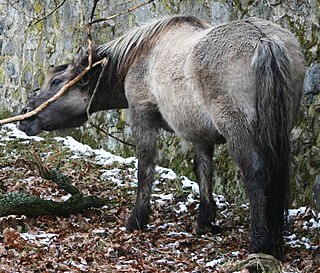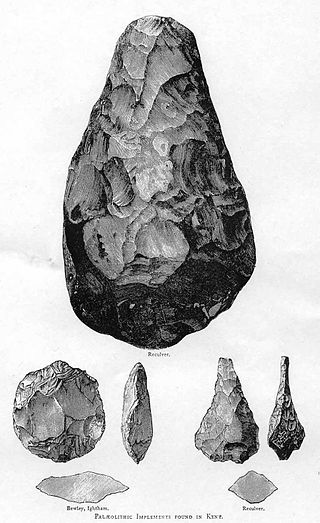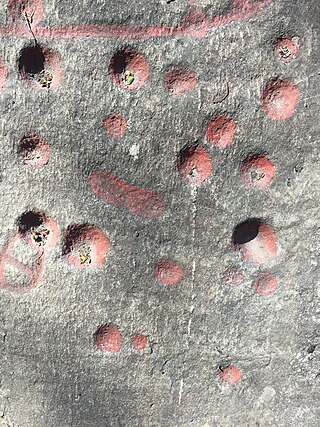
The Paleolithic or Palaeolithic, also called the Old Stone Age, is a period in human prehistory that is distinguished by the original development of stone tools, and which represents almost the entire period of human prehistoric technology. It extends from the earliest known use of stone tools by hominins, c. 3.3 million years ago, to the end of the Pleistocene, c. 11,650 cal BP.

How and when horses became domesticated has been disputed. Although horses appeared in Paleolithic cave art as early as 30,000 BC, these were wild horses and were probably hunted for meat. The clearest evidence of early use of the horse as a means of transport is from chariot burials dated c. 2000 BC. However, an increasing amount of evidence began to support the hypothesis that horses were domesticated in the Eurasian Steppes in approximately 3500 BC. Discoveries in the context of the Botai culture had suggested that Botai settlements in the Akmola Province of Kazakhstan are the location of the earliest domestication of the horse. Warmouth et al. (2012) pointed to horses having been domesticated around 3000 BC in what is now Ukraine and Western Kazakhstan.
A manuport is a natural object that has been deliberately taken from its original environment and relocated without further modification. Typically moved by human hand, some manuports are the result of other hominins. Common manuports include stones, seashells and fossils, which has led archaeologists and anthropologists to conclude they must have been chosen for their beauty. This recognition of an object’s aesthetic character suggests that certain manuports represent some of the earliest examples of art.

The Bhimbetka rock shelters are an archaeological site in central India that spans the Paleolithic and Mesolithic periods, as well as the historic period. It exhibits the earliest traces of human life in India and evidence of the Stone Age starting at the site in Acheulian times. It is located in the Raisen District in the Indian state of Madhya Pradesh, about 45 kilometres (28 mi) south-east of Bhopal. It is a UNESCO World Heritage Site that consists of seven hills and over 750 rock shelters distributed over 10 km (6.2 mi). At least some of the shelters were inhabited more than 100,000 years ago.

The Venus of Tan-Tan is an alleged artifact found in Morocco. It and its contemporary, the Venus of Berekhat Ram, have been claimed as the earliest representations of the human form.

The Upper Paleolithic is the third and last subdivision of the Paleolithic or Old Stone Age. Very broadly, it dates to between 50,000 and 12,000 years ago, according to some theories coinciding with the appearance of behavioral modernity in early modern humans, until the advent of the Neolithic Revolution and agriculture.
Cognitive archaeology is a theoretical perspective in archaeology that focuses on the ancient mind. It is divided into two main groups: evolutionary cognitive archaeology (ECA), which seeks to understand human cognitive evolution from the material record, and ideational cognitive archaeology (ICA), which focuses on the symbolic structures discernable in or inferable from past material culture.

Richard Walter Wrangham is an English anthropologist and primatologist; he is Professor of Biological Anthropology at Harvard University. His research and writing have involved ape behavior, human evolution, violence, and cooking.

Laas Geel, also spelled Laas Gaal, are cave formations on the rural outskirts of Hargeisa, Somaliland, situated in the Maroodi Jeex region of the country. They contain some of the earliest known cave paintings of domesticated African aurochs in the Horn of Africa. Laas Geel's rock art is estimated to date to circa 3,500-2,500 BCE.
This timeline of prehistory covers the time from the appearance of Homo sapiens approximately 315,000 years ago in Africa to the invention of writing, over 5,000 years ago, with the earliest records going back to 3,200 BC. Prehistory covers the time from the Paleolithic to the beginning of ancient history.
The Erfoud manuport is a 70 mm long and 35 mm wide fossilized fragment of a cuttlefish resembling naturalistic, life-size, non-erect human phallus.
Makapansgat is an archaeological location within the Makapansgat and Zwartkrans Valleys, northeast of Mokopane in Limpopo province, South Africa. It is an important palaeontological site, with the local limeworks containing Australopithecus-bearing deposits dating to between 3.0 and 2.6 million years BP. The whole Makapan Valley has been declared a South African Heritage Site. Makapansgat belongs to the Cradle of Humankind.

Self-domestication is a scientific hypothesis that suggests that, similar to domesticated animals, there has been a process of artificial selection among members of the human species conducted by humans themselves. In this way, during the process of hominization, a preference for individuals with collaborative and social behaviors would have been shown to optimize the benefit of the entire group: docility, language, and emotional intelligence would have been enhanced during this process of artificial selection. The hypothesis is raised that this is what differentiated Homo sapiens from Homo neanderthalensis and Homo erectus.

The oldest undisputed examples of figurative art are known from Europe and from Sulawesi, Indonesia, dated about 35,000 years old . Together with religion and other cultural universals of contemporary human societies, the emergence of figurative art is a necessary attribute of full behavioral modernity.

The Makapansgat pebble or Makapansgat cobble is a pebble with natural chipping and wear patterns that make it look like a crude rendition of a human face, in fact at least two possible faces. Some scholars argue that it is the oldest known manuport.
Prehistoric technology is technology that predates recorded history. History is the study of the past using written records. Anything prior to the first written accounts of history is prehistoric, including earlier technologies. About 2.5 million years before writing was developed, technology began with the earliest hominids who used stone tools, which they first used to hunt food, and later to cook.

The following outline is provided as an overview of and topical guide to prehistoric technology.
Venus of Buret' may refer to any of the five Venus figurines found from archeological site of Buret' in Siberia near Irkutsk and the Angara river valley.
Kinetic energy metamorphosis (KEM) is a tribological process of gradual crystal re-orientation and foliation of component minerals in certain rocks. It is caused by very high, localized application of kinetic energy. The required energy may be provided by prolonged battery of fluvially propelled bed load of cobbles, by glacial abrasion, tectonic deformation, and even by human action. It can result in the formation of laminae on specific metamorphic rocks that, while being chemically similar to the protolith, differ significantly in appearance and in their resistance to weathering or deformation. These tectonite layers are of whitish color and tend to survive granular or mass exfoliation much longer than the surrounding protolith.

Rock cupules are artificially made depressions on rock surfaces that resemble the shape of an inverse spherical cap or dome. They were made by direct percussion with hand-held hammer-stones, on vertical, sloping or horizontal rock surfaces. Cupules are widely believed to be the world's most common rock art motifs, found in huge numbers in every continent except Antarctica. They were produced in many cultures, from the Lower Paleolithic to the 20th century, and they can be found on most lithologies. Similar artifacts from lithic Native American cultures are also known as cupstones.











